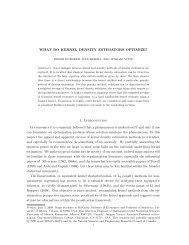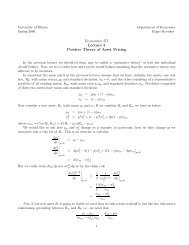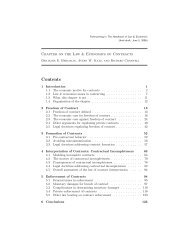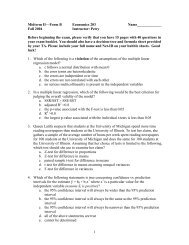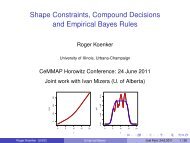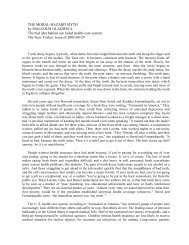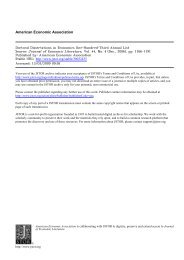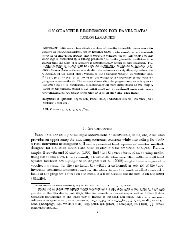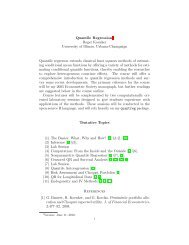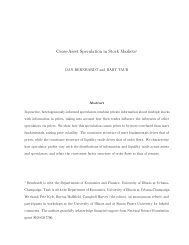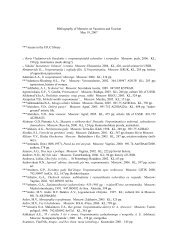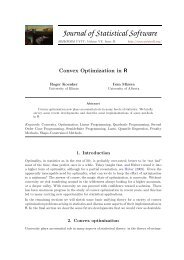1. Introduction - Econometrics at Illinois - University of Illinois at ...
1. Introduction - Econometrics at Illinois - University of Illinois at ...
1. Introduction - Econometrics at Illinois - University of Illinois at ...
You also want an ePaper? Increase the reach of your titles
YUMPU automatically turns print PDFs into web optimized ePapers that Google loves.
Roger Koenker and Zhijie Xiao 19and therefore tests can be based on K n as before. Note th<strong>at</strong> in this case estim<strong>at</strong>ion<strong>of</strong> _g provides as a byproduct an estim<strong>at</strong>or <strong>of</strong> the function ' 0 (t) which is needed tocompute the process ^v n (t).In applic<strong>at</strong>ions it will usually be desirable to restrict <strong>at</strong>tention to a closed interval[ 0 ; 1 ] (0; 1). This is easily accommod<strong>at</strong>ed, following Koul and Stute (1999),Remark 2.3, by considering the modied test st<strong>at</strong>istic,K n =sup jj~v() , ~v( 0 )jj= p 1 , 0 ;2[ 0 ; 1 ]which converges weakly, just as in the unrestricted case, to sup [0;1]jjw 0 ()jj. Thisrenormaliz<strong>at</strong>ion is useful in our empirical applic<strong>at</strong>ion, for example, since we are restricted<strong>at</strong> the outset to estim<strong>at</strong>ing the ^v process on the subinterval [ 0 ; 1 ]=[:2;:8].Indeed, it may be fruitful to consider other forms <strong>of</strong> standardiz<strong>at</strong>ion as well.5.3. The loc<strong>at</strong>ion shift hypothesis. An important special case <strong>of</strong> the loc<strong>at</strong>ionscaleshift model is, <strong>of</strong> course, the pure loc<strong>at</strong>ion shift model,F ,1y i jx i(jx i )=x > i + 0F ,10 ()This is just the classical homoscedastic linear regression model,y i = x > i + 0 u iwhere the fu i g are iid with distribution function F 0 . This model underlies much <strong>of</strong>classical econometric theory and practice. If it is found to be appropri<strong>at</strong>e then it isobviously sensible to consider estim<strong>at</strong>ion by altern<strong>at</strong>ive methods. For F 0 Gaussian,least squares would <strong>of</strong> course be optimal. For F 0 unknown one might consider theHuber M-estim<strong>at</strong>or, or its L-estim<strong>at</strong>or counterpart,Z 1,^ =(1, 2) ,1 ^()d;see Koenker and Portnoy (1987). In the loc<strong>at</strong>ion shift model it is also well-knownfrom Bickel (1982), th<strong>at</strong> the slope parameters, ( 2 ;:::; p ), are adaptively estimableprovided F 0 has nite Fisher inform<strong>at</strong>ion for the loc<strong>at</strong>ion parameter. Thus, it wouldbe reasonable to consider M-estim<strong>at</strong>ors like those described in Hsieh and Manski(1987) or the adaptive L-estim<strong>at</strong>ors described in Portnoy and Koenker (1989).The loc<strong>at</strong>ion-shift hypothesis can be expressed in standard form,R() =r;by setting R =[0.I p,1]; r =( 2 ;::: ; p ) > . It asserts simply th<strong>at</strong> the quantile regressionslopes are constant, independent <strong>of</strong>. Again, the unknown parameters infR; rg are easily estim<strong>at</strong>ed so the process ^v n () is easily constructed. The transform<strong>at</strong>ionis obviously somewh<strong>at</strong> simpler in this case since g(t) =(t; ' 0 (t)) has one fewercoordin<strong>at</strong>e than in the previous case.



